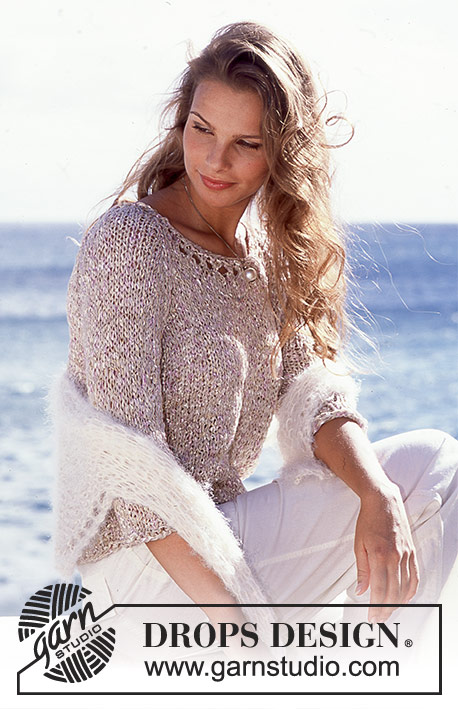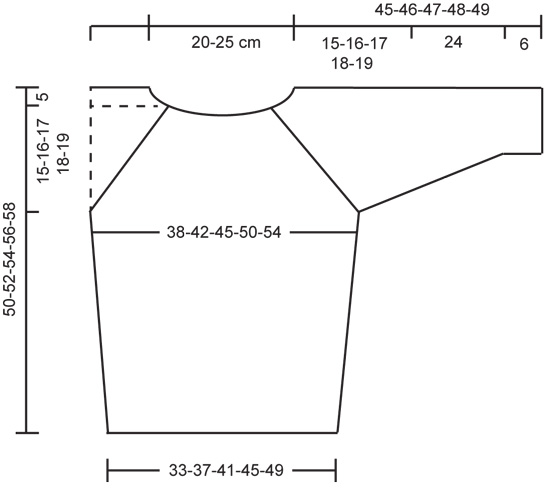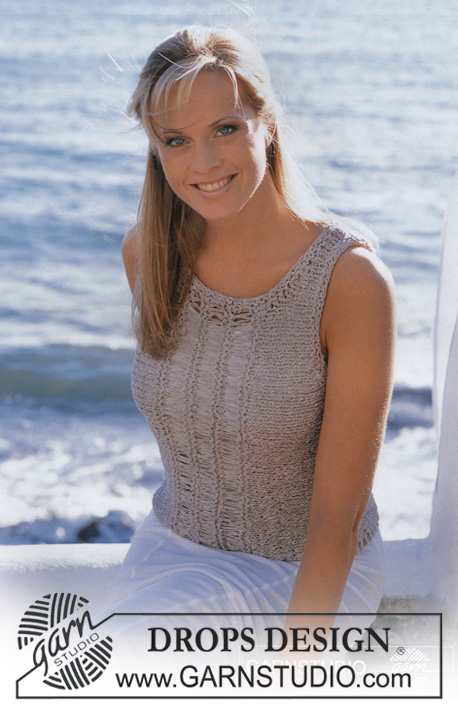Comments / Questions (6)
![]() Tanja Avenant wrote:
Tanja Avenant wrote:
Still unclear for pattern Drops 81-26. Decreasing for yoke.... ... After marking thread: lift 1 stitch off, slip stitch as if to knit, knit 1,psso..... Iift 1 stitch off seems the same as slip stitch as if to knit. Do you slip 2 stitches then?
09.08.2023 - 22:06DROPS Design answered:
Hi Tanja, You are right, the "lift one stitch off" needs to be ignored. Just slip 1 stitch knit-wise, knit 1 and pass the slipped stitch over. Happy knitting!
10.08.2023 - 06:42
![]() Tanja Avenant wrote:
Tanja Avenant wrote:
What exactly does "lift one stitch off" mean? Like slip stitch, or like cast off? (decrease for raglan)
09.08.2023 - 05:13DROPS Design answered:
Dear Mrs Avenant, to decrease after marker for raglan, slip 1 as if to knit, knit 1 and pass the slipped stitch over the knitted stitch. Happy knitting!
09.08.2023 - 08:32
![]() Gaetane Simard wrote:
Gaetane Simard wrote:
Comment augmente d un maille avant et apres le marqueur modele 81-26
29.08.2022 - 19:06DROPS Design answered:
Bonjour Mme Simard, cette vidéo montre comment vous pouvez augmenter de chaque côté du marqueur - mais vous pouvez également augmenter avec 1 jeté avant la dernière maille avant le marqueur + après la 1ère maille après le marqueur (vous avez ainsi 2 m entre les augmentations), ou bien avec toute autre technique de votre choix. Bon tricot!
30.08.2022 - 08:21
![]() Hildanery Gorbeña Alvarez wrote:
Hildanery Gorbeña Alvarez wrote:
Hola gracias por compartir tantas cosas lindas
08.07.2021 - 03:11
![]() Marcie Plotkin wrote:
Marcie Plotkin wrote:
I just got to the part where I have put the center 11 stitches from the front on a holder..so now I cannot knit in the round anymore..is this supposed to be flat knitting at this point? and how do I go about doing the decreases for the neck? Any help would be appreciated, as I am just about done and would love to finish this and wear it. THank you!
12.11.2019 - 15:40DROPS Design answered:
Dear Mrs Plotkin, yes when you have slipped the middle stitches on a thread for neck, you continue working yoke back and forth and not in the round anymore. Continue decreasing for raglan from RS as before, and at the same time, bind off the stitches for neck at the beg of every row (= from neck = both from RS and from WS). Happy knitting!
12.11.2019 - 16:01Fulvia wrote:
Buongiorno caro staff È possibile avere la traduzione in italiano di questo modello , per piacere? Grazie
01.12.2017 - 10:23DROPS Design answered:
Buongiorno Fulvia. Tradurremo il modello appena possibile. Buon lavoro!
01.12.2017 - 11:24
Rose Drops |
|
 |
 |
Top in DROPS Salsa or DROPS Melody with ¾ sleeves
DROPS 81-26 |
|
|
PULLOVER: Gauge: 13 sts x 17 rows in stockinette st = 10 x 10 cm. Knitting tips (for raglan shaping): All decs are made on right side rows. Dec 1 st as follows: Before the marker: K 2 tog. After the marker: Slip 1 st as if to knit, K 1, psso. Measuring-tips: Due to the stretchiness of the fabric, measure the garment when held up, rather than lying flat. The measurements on the diagram show the garment as worn. Body: Cast on 86-96-106-118-128 sts on circular needles with Salsa or Melody; join and place a marker at the join. Knit 2 rows garter st, then change to stockinette st. Put a marker for the other side (after 43-48-53-59-64 sts). When the piece measures 12 cm inc 1 st at each side of each marker every 8 cm a total of 3 times = 98-108-118-130-140 sts. When the piece measures 30-31-32-33-34 cm bind off 6 sts at each side (3 sts each side of each marker) for armhole = 43-48-53-59-64 sts on body. Lay piece aside and knit the sleeve. Sleeve: Cast on 26-28-30-32-34 sts on double-pointed needles; join and place a marker at the join. Knit 2 rows garter st, then change to stockinette st. When the piece measures 7 cm inc 1 st each side of marker every 3-3-3-2.5-2.5 cm a total of 8-8-8-9-9 times = 42-44-46-50-52 sts. When the piece measures 31 cm bind off 3 sts each side of marker = 36-38-40-44-46 sts. Lay piece aside and knit a second sleeve. Yoke: Put the sleeves in on the same circular needles as body where you bound off for armholes = 158-172-186-206-220 sts. Put a marker in each transition between the sleeves and body. Knit 1 row before starting raglan shaping. Read the entire next section before knitting: Raglan shaping: Dec 1 st at each side of each marker every other row 12-13-14-15-16 times – see knitting tips above. Neckband: When the piece measures 40-41-42-44-46 cm put the center front 11-12-13-15-16 sts on a st holder for the neck. Then bind off at each neck edge every other row: 2 sts 2 times and 1 st 2-2-3-3-4 times. After all raglan and neck shaping is complete, 39-44-47-57-60 sts remain on needles. Neckband: Pick up approx. 25-35 sts in the front neck (incl. sts on st holder) and put all sts on double-pointed needles. Join and K 1 row, decreasing evenly distributed on the first row to 60-64-68-72-76 sts. Knit the next row as follows: * K 2 tog, yo *, repeat from * - * across row. Then K 1 row, P 1 row, then K and bind off all sts. Assembly: Sew opening under the sleeve. SHAWL: Sizes: Width at top: approx. 150 cm [59"] Length at center back: approx. 70 cm [27⅝"] Materials: Garnstudio SYMPHONY 65% merino wool, 35% nylon, 50 g./70 m./76 yards 100 gr nr 01, natural DROPS 15 mm [US 19] needles, or size needed to obtain correct gauge. Gauge: 5 sts x 10 rows in garter st = 10 x 10 cm. Increasing tips: Inc 1 st inside of 2 sts at each side by making a yo. Shawl: Loosely cast on 5 sts and knit garter st over all sts, increasing every other row - see Increasing tips. Inc until you have 75 sts, then knit 1 row increasing 1 st in every other st, then bind off with double strands of yarn. |
|

|
|
Have you finished this pattern?Tag your pictures with #dropspattern or submit them to the #dropsfan gallery. Do you need help with this pattern?You'll find 24 tutorial videos, a Comments/Questions area and more by visiting the pattern on garnstudio.com. © 1982-2025 DROPS Design A/S. We reserve all rights. This document, including all its sub-sections, has copyrights. Read more about what you can do with our patterns at the bottom of each pattern on our site. |
|






























































Post a comment to pattern DROPS 81-26
We would love to hear what you have to say about this pattern!
If you want to leave a question, please make sure you select the correct category in the form below, to speed up the answering process. Required fields are marked *.